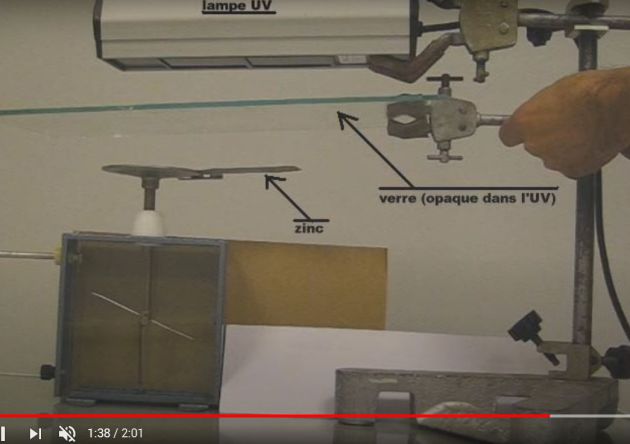Photoelectric effect
Fondamental :
Photoelectric effect was discovered randomly by Heinrich Hertz as he was trying to reveal electromagnetic waves predicted by Maxwell's theory.
He did not however pay a lot of attention to this phenomenon.
The systematic study was then made by Lenard.
A metal plate, lit by a light beam of frequency \(\nu\), emits electrons in several directions :
Under a certain threshold of the frequency of radiation, written \(\nu_0\), no electron is emitted.
The emission of electrons is not conditioned by the intensity of the radiation but only by its frequency.
Hence, if the intensity of radiation is lightly increased at a frequency inferior to the electron emission threshold, no electron is emitted.

In a classical context, the emission of electrons can be explained by the fact that radiation brings energy to the atoms.
After a certain while, the quantity of energy transferred to the atoms is enough to rip away the peripheral electrons.
However, this emission is in no way conditioned by the frequency of the radiation but rather by its intensity, which means by the quantity of energy it is susceptible to communicate to the atoms.
Hence, this effect should be observed for any frequency of radiation.
Yet experiments clearly show it is not the case.
The energy threshold above which the electrons are emitted can easily be explained by supposing the electrons are usually in a tied state within the atoms.
The value of the binding energy is a characteristic proper to each element, written \(E_0\).
Einstein, in 1905, although he was very young, had the idea of introducing the concept of quantum.
The classic interpretation supposed that the energy contribution operated by the radiation was continuous. However, the quanta theory proposed that the exchange of energy between the radiation and matter could only be made through finite packs of value \(E=h\nu\), where \(\nu\) is the frequency of the electromagnetic waves.
Using this idea, Einstein determined the kinetic energy \(E_c\) of the electrons emitted :
\(E_c=h\nu - E_0\)
\(\nu_0\) is the frequency above which the photoelectric effect is observed. It corresponds to a kinetic energy of emission of the electrons equal to zero.
Consequently :
\(\nu_0=\frac{E_0}{h}\)
This value matches perfectly all experimental measures.
Einstein's interpretation of the photoelectric effect is not reduced to a simple application of Max Planck's hypothesis of quanta.
Of course it constitutes a brilliant confirmation of this hypothesis, but Einstein significantly changed the physical meaning that Planck had given to it.
According to Max Planck, the quanta reflected the manner in which matter interacted with the electromagnetic radiation. The radiation kept its continuous nature but it was supposed to be absorbed and emitted by packs, in a discontinuous manner.
What Einstein's interpretation means is completely different.
Light is made of packs of energy which are absorbed and emitted by matter.
The discontinuous nature of quanta is no longer only a property of the interaction between matter and radiation but also an intrinsic characteristic of radiation itself.
Only one year after the publication of his article about photoelectric effect interpretation, Albert Einstein pushed his idea even further : he formulated the hypothesis that light (or any electromagnetic radiation) was composed of grains or corpuscles.
He named these light grains "photons".
This hypothesis was simply revolutionary because it openly defied one of the pillars of physics of nineteenth century : Maxwell's theory on electromagnetism.
This theory had demonstrated, while corresponding perfectly to the experiments at the time, that light was an electromagnetic wave.
Many experiments such as what Young did on interferences (Young's double-slit experiment), and what Fresnel found on diffraction, had firmly established the wave-like nature of light.
Hence it could seem absurd to propose a corpuscular model for light.
However, photoelectric effect could not be understood correctly without the introduction of photons.
